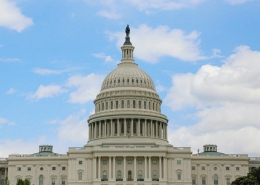On Wednesday, March 6th, Chair Maria Cantwell (D-WA) convened a hearing for the Senate Committee on Commerce, Science, and Transportation to discuss ongoing investigations and operations of the National Transportation Safety Board, with particular attention given to the recent in-flight Boeing equipment failure on Alaska Airlines flight 1282.
The National Transportation Safety Board (NTSB), often referred to as the nation’s safety watchdog, is an independent federal agency tasked with investigating accidents and incidents for the transportation sector. NTSB Chair Jennifer Homendy came before the committee to share updates on various transportation incident investigations with particular attention to the Alaska Airlines incident, greater transportation incidents and safety recommendations, and agency operations and funding. Her full testimony can be found here.
Investigations
The primary purpose of the hearing was to discuss Alaska Airlines flight 1282, and the related challenges with transparency and information sharing from the aircraft manufacturer – Boeing. The flight in question took off from Portland, Oregon on January 5th of this year. Shortly after takeoff, the door panel of the Boeing 737 Max 9 experienced an equipment failure which caused the door to release from the aircraft, leaving a gaping hole in the plane. The plane was able to return for an emergency landing in Portland, and while there were injuries, there were no fatalities in the incident.
Following that incident, NTSB was tasked with investigating how the equipment failure occurred and what steps would need to be taken to address the oversight. Between questions from members and Chair Homendy’s testimony, concerns centered around Boeing’s willingness to share information, its safety record, and overall safety culture.
Information Sharing
On February 6th, NTSB released a preliminary report detailing early findings of potential causes and factors in the flight 1282 malfunction. In opening comments, Chair Cantwell mentioned a few findings, but a primarily mentioned the possibility that Boeing facilities have significant deficiencies in recordkeeping.
Chair Homendy discussed the challenges in acquiring necessary information from Boeing for their investigation, including records detailing the shifts during which the work on this equipment occurred and the names of those on Boeing’s 25-member team specifically tasked with working on aircraft doors. Homendy further detailed that the agency was forced to rely on direct contacts from three employees who work on the rivets to discover that these employees are contractors not employed by Boeing.
In an intense back-and-forth with Senator Cruz (R-TX), both parties seemed to express their shock in how this information has not been shared after months of repeated requests, which ended in Sen. Cruz specifically calling for Chair Homendy to provide documentation on any opening and closing of the door plug, the names of the 25-member door team, and related information by March 13th – aimed mostly at Boeing of course.
Safety Record and Culture
Given the prevalence of media attention around high-visibility events of this nature, it is worth noting that flying continues to be an incredibly safe of travel for the public. In a recent study, the International Air Transport Association (IATA) reported five fatal accidents in the 32.2 million flights taken in 2022.
Nonetheless, the committee spent considerable time discussing the safety record and safety culture at Boeing. Members made mention of the Boeing and McDonnell Douglas merger in the late 1990s with theories that safety began to erode in favor of profit at that time, limited transparency issues on MCAS software in 737 Max aircrafts and related new training requirements for pilots, and a culture of fear in reporting safety issues amongst Boeing employees.
Chair Homendy expressed intent to work closely with the Federal Aviation Administration on issues for Boeing, but she also expressed the need to improve safety in the aviation industry overall, updating various technologies needed to enhance safety like ground surveillance radars and better supporting the aviation workforce.
Transportation Incidents and Safety
The hearing also covered many current and past investigations undertaken by NTSB. Some of those mentioned, which highlight the breadth and importance of agency work included the following:
- Norfolk Southern train derailment in East Palestine, Ohio
- Tesla crashes and vehicle recalls nationwide
- Natural gas-fueled home explosions and fires in Jackson, Mississippi
- EV crash incidence and firefight response techniques
- A multivehicle crash, including a motorcoach carrying members of a high school band in Etna, Ohio
- A plane crash which killed two adults and three children in Nashville, Tennessee
- A train derailment in Raymond, Minnesota
- A Hawaii helicopter tour crash which killed 6 passengers and the pilot
- A multivehicle crash between a motorcoach and tractor-trailers parked along a rest area ramp in Highland, Illinois
- A truck colliding with a group of bicyclists in Goodyear, Arizona
- A hot air balloon accident in Eloy, Arizona
- A mid-air collision at the Wings Over Dallas airshow in Dallas, Texas
- Train derailment in Desoto, Wisconsin
The conversation on these different types of transportation incidents reflected the critical nature of the agency. While the hearing was largely focused on the recent Boeing incident, another major name in the hearing conversation was Norfolk Southern, which experienced a train derailment in East Palestine, Ohio last year.
During his opportunity for questions, Senator J.D. Vance (R-OH) delivered very concise questions to Chair Homendy to sharply convey the point that Norfolk Southern and local law enforcement were likely unjustified in opting to explode cars and burn toxic chemicals, potentially causing long-term health issues for nearby residents, rather than letting the materials cool down.
The array and severity of incidents clearly outlines the need for NTSB and the agency’s importance as an investigative agency – further reiterated by mention of the agency’s more than 1,000 currently open safety recommendations.
NTSB Operation and Funding
The importance of NTSB was apparent from start to end within the hearing. The agency handles approximately 2,200 domestic and 450 foreign cases in a year. Transportation incidents remain high, and due to technological developments, these cases are increasing in complexity. Right now, the agency has 1,200 open investigations between 47 states and Puerto Rico. An additional 140 foreign cases are active.
When Chair Homendy was sworn into her position in August of 2021, NTSB had a backlog of more than 500 cases and a staff of 397 individuals. The agency was able to grow to 444 employees and address all backlogged cases before a continuing resolution last fall froze hiring. The number of staff has now fallen to 429, and the number of backlogged cases has risen to 15.
After reauthorization expiration at the end of fiscal year 2022, Chair Homendy expressed endless gratitude for inclusion of NTSB reauthorization in the Senate version of the FAA Reauthorization. Additionally, NTSB is slated to receive an 8.2 percent appropriations increase before seeing flat funding in the years following. While a great sign for the agency, Chair Homendy and members were quick to acknowledge that demand for transportation safety is not declining in the coming years. As we continue to see increased travel and growth in technologies like advanced air mobility and autonomous vehicle applications, as well as vehicle structure and weight changes seen for electric vehicles, the agency will continue to need resources to serve its watchdog function.













